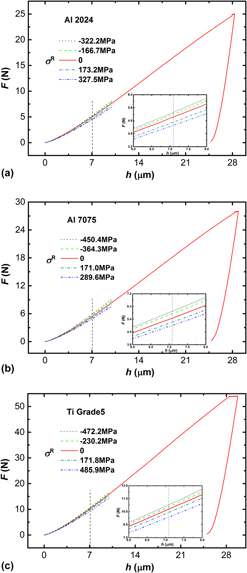Crossref Citations
This article has been cited by the following publications. This list is generated based on data provided by
Crossref.
Chen, Hui
Cai, Li-xun
and
Bao, Chen
2019.
Equivalent-energy indentation method to predict the tensile properties of light alloys.
Materials & Design,
Vol. 162,
Issue. ,
p.
322.
Feng, Biao
and
Liu, Zhen
2019.
Finite element modeling and simulations on indentation and scratch tests on thin films: effects of prestress.
MRS Communications,
Vol. 9,
Issue. 2,
p.
756.
OKANO, Shigetaka
2019.
Measurement of Residual Stress at Welds by Instrumented Indentation Techniques.
JOURNAL OF THE JAPAN WELDING SOCIETY,
Vol. 88,
Issue. 6,
p.
480.
Zhang, Taihua
Cheng, Wenqiang
Peng, Guangjian
Ma, Yi
Jiang, Weifeng
Hu, Jiangjiang
and
Chen, Heng
2019.
Numerical investigation of spherical indentation on elastic-power-law strain-hardening solids with non-equibiaxial residual stresses.
MRS Communications,
Vol. 9,
Issue. 1,
p.
360.
Yuan, Lingxiao
Yuan, Weike
and
Wang, Gangfeng
2020.
Effects of Residual Stress on the Hardness of Elastoplastic Material Under Spherical Indentation.
Journal of Applied Mechanics,
Vol. 87,
Issue. 5,
Moharrami, R.
and
Sanayei, M.
2020.
Developing a method in measuring residual stress on steel alloys by instrumented indentation technique.
Measurement,
Vol. 158,
Issue. ,
p.
107718.
Diaz, F. V.
Rosso, F. N.
Walker, A. C.
and
Guidobono, A. P. M.
2020.
On the Correlation Between Residual Stresses and Displacements of the Polycrystalline Lattice: an Experimental Strategy.
International Journal of Mechanics,
Vol. 14,
Issue. ,
p.
208.
Peng, Guangjian
Xu, Fenglei
Chen, Jianfeng
Hu, Yahao
Wang, Huadong
and
Zhang, Taihua
2020.
A cost-effective voice coil motor-based portable micro-indentation device for in situ testing.
Measurement,
Vol. 165,
Issue. ,
p.
108105.
Peng, Guangjian
Xu, Fenglei
Chen, Jianfeng
Wang, Huadong
Hu, Jiangjiang
and
Zhang, Taihua
2020.
Evaluation of Non-Equibiaxial Residual Stresses in Metallic Materials via Instrumented Spherical Indentation.
Metals,
Vol. 10,
Issue. 4,
p.
440.
Clyne, Trevor William
Campbell, Jimmy Edward
Burley, Max
and
Dean, James
2021.
Profilometry‐Based Inverse Finite Element Method Indentation Plastometry.
Advanced Engineering Materials,
Vol. 23,
Issue. 9,
Greco, Alessia
Sgambitterra, Emanuele
and
Furgiuele, Franco
2021.
A new methodology for measuring residual stress using a modified Berkovich nano-indenter.
International Journal of Mechanical Sciences,
Vol. 207,
Issue. ,
p.
106662.
Aydin, O.
and
Simsir, C.
2021.
Application of the contour method to determine axial residual stresses in cold extruded steel rods.
FME Transactions,
Vol. 49,
Issue. 4,
p.
941.
Zhang, Xiaocheng
Guan, Kaishu
Zhong, Jiru
Chen, Guoyao
Wang, Wulin
and
Wang, Qiongqi
2021.
A macro-pillar compression technique for determining true stress-strain curves of steels.
Measurement,
Vol. 168,
Issue. ,
p.
108407.
Zhou, Wei
Wang, Hong-bin
and
Huo, Qing-hui
2021.
Study on Indentation Response of Cold Rolled Strip Steel.
Journal of Materials Engineering and Performance,
Vol. 30,
Issue. 8,
p.
5931.
Larsson, Per-Lennart
2021.
On the Behavior of Mechanical Stress Fields at Indentation of Materials with Residual Stresses.
Journal of Materials Engineering and Performance,
Vol. 30,
Issue. 4,
p.
2566.
Liang, Tong
Yuan, Weike
and
Wang, Gangfeng
2021.
Influence of Equi-Biaxial Residual Stress on Spherical Indentation of Strain Hardening Materials.
International Journal of Applied Mechanics,
Vol. 13,
Issue. 05,
Wang, Qiudong
Ji, Bohai
Fu, Zhongqiu
and
Xu, Zhaodong
2021.
Experimental study on the determination of welding residual stress in rib-deck weld by sharp indentation testing.
Thin-Walled Structures,
Vol. 161,
Issue. ,
p.
107516.
Zhou, Wei
Wang, Hong-bin
Wang, Quan
and
Huo, Qing-hui
2021.
Scratch resistance analysis of steel strip through nanoindentation method.
MRS Communications,
Vol. 11,
Issue. 6,
p.
936.
Burley, Max
Campbell, Jimmy E
Reiff-Musgrove, Rebecca
Dean, James
and
Clyne, Trevor William
2021.
The Effect of Residual Stresses on Stress–Strain Curves Obtained via Profilometry‐Based Inverse Finite Element Method Indentation Plastometry.
Advanced Engineering Materials,
Vol. 23,
Issue. 5,
2021.
Testing of the Plastic Deformation of Metals.
p.
148.





